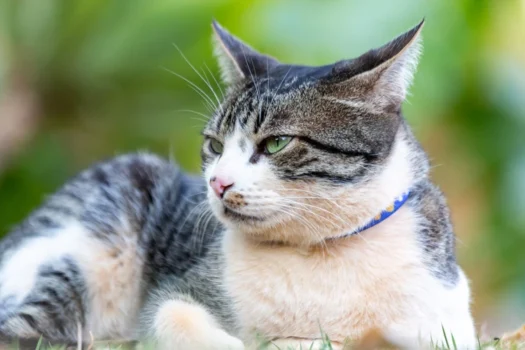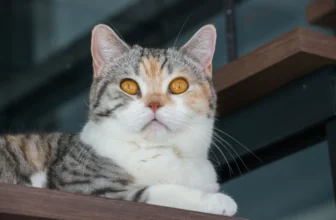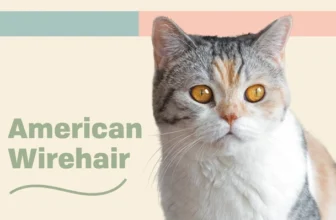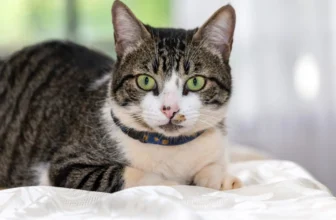Have you ever wondered about the importance of dental care for your American Wirehair cat? Oral health is just as important for cats as it is for humans. Neglecting your cat’s dental hygiene could lead to serious dental issues, which can cause discomfort and pain. With regular dental care, you can keep your cat’s teeth healthy and prevent dental diseases. In this article, we will explore the anatomy of a cat’s teeth, common dental diseases in American Wirehairs, and the benefits of dental care. We’ll also provide tips on how to keep your cat’s teeth healthy and what to expect during dental checkups.
Understanding American Wirehair Oral Health

Cats are known for their agility, intelligence, and curious nature, but their oral health is often overlooked by owners. It’s important to understand the unique oral health needs of American Wirehairs to ensure that they lead healthy, happy lives. Poor oral health can lead to a range of health problems, including gum disease, tooth decay, and other systemic health problems. In this article, we will delve into the anatomy of a cat’s teeth and explore common dental diseases that can affect American Wirehairs. We will also outline the benefits of dental care and discuss practical tips for keeping your cat’s teeth healthy. By the end of this section, you will have a deeper understanding of American Wirehair oral health and be equipped with the knowledge to keep your cat’s smile bright. To learn more about maintaining other areas of your cat’s health, click here /amwire-allergy-mgmt/.
Anatomy of a Cat’s Teeth
The oral cavity of a cat is an important part of overall health and well-being, and it is essential for American Wirehairs to maintain good oral hygiene to prevent dental diseases. Understanding the anatomy of a cat’s teeth is crucial to locating potential dental issues in your American Wirehair.
Cats have four different types of teeth: incisors, canines, premolars, and molars. At the front of their mouths, cats have twelve tiny, sharp teeth called incisors, which they use for grooming and biting. These teeth allow them to snack on small prey, such as mice and birds. On either side of the incisors, your cat has two long, sharp teeth called canines, which help them catch their prey and bite into larger food products.
As we move towards the back of the cat’s mouth, we find premolars and molars. These teeth have flat surfaces that help cats to grind and crush their food. Premolars are located just behind the canines. Cats typically have two upper and lower premolars on each side of their mouths, making a total of eight premolars. Molars, on the other hand, are located near the back of the mouth. Unlike premolars, cats usually have two molars on each side of their upper jaw, and three on each side of the lower jaw. This makes cats more efficient at crushing and grinding their food.
It is quite common for American Wirehairs to experience dental issues caused by a buildup of plaque and tartar, leading to tooth decay and gum problems. As a cat owner, it is essential to recognize and address dental issues before they become severe (GI problems) or cause other health problems such as (ear infections). Fortunately, with proper dental care, many of these issues can be prevented.
Dental Diseases in American Wirehairs
American Wirehairs aren’t immune to dental diseases, and the consequences can be severe if their dental issues are left untreated. In fact, dental problems are one of the most common health problems found in cats including American Wirehairs. The consequences of dental problems can lead to tooth loss, infection, and even bone loss. In order to take proper care of your American Wirehair’s teeth, it’s important to know what dental diseases they are prone to and what warning signs to look out for.
Dental diseases in American Wirehairs usually develop as a result of poor dental hygiene, lack of proper dental care, and unhealthy diets. The most common dental diseases in American Wirehairs include:
| Dental Disease | Description |
|---|---|
| Gingivitis | Swollen and red gums caused by the buildup of plaque and bacteria. It is reversible if caught early and treated immediately. |
| Periodontitis | A more severe form of gingivitis that leads to a loss of the bone and tissues surrounding the tooth. This is irreversible and can lead to tooth loss if not treated. |
| Tooth resorption | Also known as cavities or caries, this is the destruction of the tooth structure caused by bacteria and plaque buildup. It can lead to tooth loss and infection. |
| Stomatitis | An autoimmune disease that causes inflammation of the mouth and gums, resulting in painful, swollen, and bleeding gums. |
| Oral cancer | A malignant growth that can develop in the mouth, tongue, and gums. It can cause tooth loss, difficulty eating, and infections. |
If your American Wirehair is displaying signs such as bad breath, drooling, pawing at their mouth, decreased appetite, or loose teeth, it is important to take them to the vet immediately. A regular dental checkup and cleaning can help prevent these dental diseases from occurring in the first place, which will save you and your cat from costly vet bills and painful procedures.
Incorporating a good preventative dental care routine into your cat’s life is crucial. Creating a healthy diet, utilizing dental chews, and scheduling regular vet checkups can all help to prevent dental diseases and maintain the overall health of your American Wirehair. Ensuring your American Wirehair maintains a healthy weight (link to /american-wirehairs-healthy-weight/), preventing hairballs (link to /preventing-hairballs-american-wirehairs/), and receiving regular vet checkups (link to /benefits-vet-checkups-american-wirehairs/) can all help to maintain your cat’s overall health and wellbeing.
The Benefits of Dental Care

Healthy teeth are an important part of overall health for American Wirehairs and investing in dental care can have numerous benefits for both you and your furry friend. From fresh breath to preventing health problems, there are compelling reasons to prioritize your cat’s dental hygiene. In this section of the article, we will explore the benefits of dental care for American Wirehairs and how it can positively impact their lives.
Fresh Breath and Oral Hygiene
Fresh breath and oral hygiene are essential to American Wirehair’s overall health. Bad breath can be a sign of dental disease or other health problems and can lead to discomfort while eating and drinking. Here are some ways in which dental care can benefit your American Wirehair’s oral hygiene:
- Reduces Bad Breath: Regular dental care routine can help reduce bad breath in cats.
- Prevents Plaque and Tartar Buildup: Brushing your cat’s teeth regularly and providing them with appropriate dental chews can reduce plaque and tartar buildup.
- Prevents Gum Disease: Gum disease can affect your cat’s overall health and well-being, so it’s important to keep their gums healthy.
- Prevents tooth loss: Untreated dental disease can cause tooth decay and ultimately, tooth loss.
Maintaining good oral hygiene is crucial for American Wirehairs to have a happy and healthy life. It is important to remember that regular dental care routines, such as brushing, feeding a good diet, and providing dental chews, work together to help prevent dental diseases and oral health issues. By taking good care of your cat’s teeth and gums, you can help them maintain fresh breath, improve their overall oral hygiene, and prevent further health issues.
Preventing Tooth Decay and Gum Disease
Maintaining good dental hygiene for American Wirehairs involves preventing tooth decay and gum disease. Periodontal disease is the most common dental problem for cats and can quickly lead to tooth decay and eventual tooth loss if left untreated.
One way to prevent tooth decay and gum disease is through regular brushing. Brushing your cat’s teeth at least three times a week with a toothbrush and pet-safe toothpaste can help remove plaque and bacteria buildup. It is important to note that human toothpaste should never be used on cats as it can be toxic.
Another way to prevent dental problems is by feeding a good diet. A diet full of essential vitamins and minerals can help support healthy teeth and gums. Be sure to choose a high-quality, nutritious pet food that is recommended for your cat’s specific breed and stage of life. Providing dental chews can also help promote healthy teeth by reducing plaque buildup while satisfying your cat’s desire to chew.
In addition to at-home dental care, it’s important to bring your American Wirehair for regular dental checkups with a veterinary professional. During these checkups, the veterinarian will examine your cat’s mouth for any signs of dental problems. Early detection of dental problems can prevent the need for more invasive and costly procedures in the future.
By practicing good dental hygiene for your American Wirehair, you can help prevent tooth decay and gum disease and promote a healthy, happy lifestyle for your feline friend.
| Preventing Tooth Decay and Gum Disease Tips: |
|---|
| Regular brushing three times a week with pet-safe toothpaste |
| Feeding a high-quality, nutritious pet food recommended for your cat’s stage of life |
| Providing dental chews for plaque reduction and chewing satisfaction |
| Scheduling regular dental checkups with a veterinary professional for early detection of dental problems |
Preventing Other Health Problems
Preventing Other Health Problems:
Keeping your American Wirehair’s teeth clean not only benefits their oral health, but it can also prevent other health problems. When plaque and tartar build up on your cat’s teeth, it can lead to the growth of harmful bacteria that can enter their bloodstream, causing infections and inflammation in other parts of their body.
To prevent these potential health problems, it’s crucial to maintain your cat’s oral hygiene. Regular teeth cleaning can reduce the risk of heart, liver and kidney problems in cats. Cats with dental diseases are more likely to have diabetes too. By keeping your cat’s teeth free of plaque and tartar, you can improve their overall health.
Other potential health problems, which can be prevented through dental care, include periodontal disease and tooth loss. By ensuring a healthy oral environment for your American Wirehair, you can reduce their risk of developing these painful conditions. In turn, this can contribute to their improved mobility, better appetite, and comfortable living.
Take action now to protect your cat’s teeth and their overall health. Follow the steps for proper oral hygiene and schedule regular checkups with your veterinarian. Consider using dental chews, water additives, and a proper diet to support your cat’s dental health and overall wellness. Remember, prevention is better than cure.
How to Keep Your Cat’s Teeth Healthy
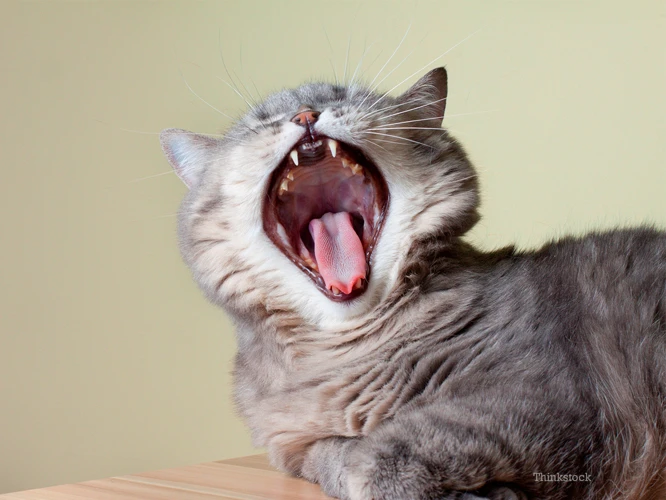
As a pet parent, you want your American Wirehair to have the best of health. One of the essential aspects of maintaining your cat’s well-being is taking care of their oral hygiene. Keeping your cat’s teeth healthy is crucial to prevent dental problems and other health issues that could arise from those problems. Here are some tips that you can follow to keep your feline’s teeth and gums healthy and strong.
Regular Dental Checkups
Regular dental checkups for American Wirehairs are crucial in maintaining good oral health. As a responsible pet owner, it’s important to schedule annual dental checkups with your veterinarian in order to catch any dental issues before they become serious problems. During the checkup, the veterinarian will examine your cat’s teeth, gums, and mouth to check for any signs of disease. They may also take x-rays to detect any hidden issues that might not be visible to the naked eye.
To make sure your cat is comfortable during the checkup, you may want to consider preparing them beforehand. Try to get them used to having their mouth examined by gently rubbing their gums with your finger or a soft bristle toothbrush. Additionally, you can reward them with a treat after each training session to make it a positive experience.
Regular dental checkups are especially important for senior cats, as they are at a higher risk for dental problems. During the checkup, your veterinarian may recommend a blood test to make sure your cat is healthy enough to undergo any necessary dental procedures.
Taking your American Wirehair for regular dental checkups not only helps maintain their oral health but also their overall well-being. So book that appointment with the veterinarian today. Additionally, you may follow these steps to keep your cat’s teeth healthy between dental checkups.
Brushing Your Cat’s Teeth
Maintaining your American Wirehair’s oral hygiene requires brushing their teeth regularly. This may seem like a daunting task, but with patience and practice, it can become a routine bonding experience between you and your furry friend.
Why Brush Your Cat’s Teeth?
Just like in humans, brushing your cat’s teeth can help prevent tooth decay and gum disease. Regular brushing also helps freshen their breath and ensure their overall health. Keep in mind that American Wirehairs are prone to dental diseases, so it’s crucial to build a regular dental routine for them.
Steps to Brush Your Cat’s Teeth
Here’s a step-by-step guide to brushing your cat’s teeth:
| Step 1: | Introduce your cat to the toothbrush gradually. First, let them sniff and taste the toothpaste before placing any on their teeth. Allow them to become accustomed to the toothpaste before increasing the brushing process. |
| Step 2: | Position your cat and lift their lip gently, avoiding any sudden movements or actions that might distress them. |
| Step 3: | Using a toothbrush specifically designed for cats, brush your cat’s teeth gently in a circular motion, moving from back to front on both the upper and lower jaw. |
| Step 4: | Focus on the outside surfaces of their teeth as this is where tartar and plaque tend to build up. Be sure to brush the back molars as they are more susceptible to dental diseases. |
| Step 5: | Reward your American Wirehair with a treat or words of affection to help ensure a positive experience for your cat. |
Choosing the Right Toothbrush and Toothpaste
It is advisable to use a toothbrush and toothpaste designed specifically for cats. Your veterinarian may make recommendations based on your cat’s individual dental needs. Never use toothpaste meant for humans as these may contain ingredients that are toxic to cats.
Brushing your cat’s teeth is vital for their oral hygiene and overall health. Starting this routine early, being patient, and providing treats or words of encouragement can make brushing their teeth an enjoyable experience for both you and your American Wirehair.
Feeding a Good Diet and Dental Chews
Feeding a nutritious diet and providing dental chews are crucial for maintaining your American Wirehair’s oral health. By feeding them with high-quality food that is rich in essential vitamins and minerals, you can help promote a strong immune system, which plays a crucial role in preventing dental diseases.
Here are some dietary dos and don’ts for your American Wirehair:
- Do provide your cat with a balanced diet that is high in protein and low in carbohydrates. Meat should be the primary ingredient in their food.
- Don’t give your cat too many treats or human food, especially those that are high in sugars and carbohydrates.
- Do offer your cat dental chews that are specifically designed to promote oral health. These chews can help remove plaque and tartar from your cat’s teeth, reducing their chances of developing dental diseases.
- Don’t give your cat bones or hard treats that can potentially damage their teeth or cause digestive issues.
It is crucial to note that different cats have different dietary requirements. Consultation with a veterinary nutritionist and your veterinarian can help you determine the best diet for your American Wirehair. Additionally, dental chews may not be suitable for all cats, especially if they have dental problems. Always check with your veterinarian before introducing a new food or treat to your cat’s diet.
Water Additives
Water additives are a convenient and easy way to promote dental health in American Wirehairs. These liquid solutions are added to your cat’s drinking water, and they work by killing the bacteria in your cat’s mouth that cause bad breath and dental problems. Some water additives even contain ingredients that help to strengthen your cat’s teeth and gums.
The benefits of using water additives:
- Can be an easy way to achieve better dental health for your cat, especially if they are resistant to having their teeth brushed
- Can help to promote fresher breath and healthier gums
- Can reduce the need for dental procedures in the future
Some popular ingredients in water additives:
- Chlorhexidine – a powerful antimicrobial agent that helps to kill bacteria
- Stevia – a natural sweetener that can be used to make the water additive more palatable for your cat
- Vitamin C – an antioxidant that can help to promote healthy gums
Tips for using water additives:
- Make sure to use a water additive that is specifically designed for cats, as some additives for humans or dogs may contain ingredients that are harmful to cats
- Start with a small amount of the water additive and gradually increase the amount over time to allow your cat to adjust to the new taste
- Regularly clean your cat’s water bowl to prevent bacteria buildup and ensure that the water additive remains effective
Remember, while water additives can be a helpful addition to your cat’s dental care routine, they should not be used as a substitute for brushing or regular dental checkups. However, when used in conjunction with a good diet, brushing, and regular vet visits, water additives can be an effective tool in promoting better dental health for your American Wirehair.
What to Expect During Dental Checkups
As a responsible American Wirehair owner, you must understand the importance of dental checkups for your furry friend. During these checkups, your veterinarian will examine your cat’s oral health and recommend appropriate treatment. This can be a daunting experience for both you and your pet, but it is essential to keep your cat’s teeth and gums healthy. In this section, we will guide you through what to expect during a dental checkup, including examination, cleaning and scaling, and the potential treatment of any dental problems.
Examination
During a dental checkup for an American Wirehair, the examination is an essential component of the process. The vet will inspect your cat’s teeth, gums, and mouth for any signs of dental disease or other oral problems. This step is crucial to detect any dental issues in the early stages when they can be treated more easily.
To give you a better understanding of what to expect during the examination, here is a breakdown of the process:
| Step 1: | The vet will first conduct a physical exam of your cat to check for any visible signs of dental disease such as swollen gums, tooth fractures, or discolored teeth. |
| Step 2: | Next, the vet will use a specialized dental probe to check for periodontal pockets, which occur when the gums pull away from the teeth and create a space that can harbor bacteria. |
| Step 3: | The vet will examine the surfaces of the teeth, looking for any signs of plaque and tartar buildup. Plaque is a sticky film of bacteria that coats the teeth, and if not effectively removed, can lead to tartar which is harder to remove and can cause more severe dental problems. |
| Step 4: | If your cat has any loose teeth or bleeding gums, the vet will check for the presence of an oral tumor in these areas. Oral tumors can be benign or malignant and require immediate attention to prevent further complications. |
| Step 5: | The vet will check the cat’s jaw and throat areas for any lumps, bumps, or masses. Any swelling or unusual growth could be an indication of a more severe condition, like oral cancer. |
By performing a thorough examination, your vet can identify any dental problems and develop an appropriate treatment plan. Depending on the severity of the issue, the vet may recommend dental cleanings, treatment, or X-rays. Remember, regular dental checkups are vital to maintaining your American Wirehair’s overall health and wellbeing.
Cleaning and Scaling
During a dental checkup, your veterinarian may recommend a cleaning and scaling procedure for your American Wirehair. This procedure is crucial for maintaining your cat’s oral health and preventing dental diseases.
Cleaning: During the cleaning procedure, your veterinarian will use special tools to remove plaque and tartar from your cat’s teeth. Plaque is a sticky film that forms on the teeth, and if allowed to accumulate, it can harden into tartar. Tartar is a hard, yellowish deposit that builds up on the teeth and can cause inflammation and infection of the gums. Preventing tartar buildup is essential for maintaining your cat’s oral health.
Scaling: Scaling is the process of removing tartar from the teeth. Your veterinarian will use a scaler to gently scrape the tartar from the tooth surface. This process is vital because tartar accumulation can lead to periodontal disease, a bacterial infection that affects the gums and can cause tooth loss and other health problems.
When performing a cleaning and scaling procedure, your veterinarian may use sedation to keep your American Wirehair calm and relaxed. This ensures that the procedure is performed safely and effectively.
After the cleaning and scaling, your veterinarian may also apply fluoride to your cat’s teeth to help strengthen the enamel and prevent decay. It’s essential to follow your veterinarian’s post-procedure instructions carefully to ensure the best possible outcome and to keep your cat’s teeth healthy.
Cleaning and scaling are essential procedures for maintaining your cat’s oral health and preventing dental diseases. Regular dental checkups and cleanings can help your American Wirehair live a happier, healthier life.
Treatment of Dental Problems
When an American Wirehair cat has dental problems, such as tooth decay or gum disease, the veterinarian may recommend certain treatments to alleviate the issues. Depending on the severity of the problem, treatment options may vary.
Dental Procedures:
| Treatment | Description |
|---|---|
| Extraction | If a tooth is severely damaged or infected, it may need to be extracted. The veterinarian will remove the tooth from the gum, and the cat will need to be under anesthesia. |
| Filling or Root Canal | If a tooth has a cavity or a nerve issue, the veterinarian may recommend a filling or a root canal. This procedure will also require the cat to be under anesthesia. |
| Antibiotics | If the cat has a dental infection, the veterinarian may prescribe antibiotics to treat the infection. This will help to reduce inflammation and eliminate harmful bacteria. |
Oral Medications:
If a cat has mild dental problems, such as gingivitis or plaque buildup, the veterinarian may prescribe oral medication to alleviate the problem. Some options include:
- Anti-inflammatory: To reduce inflammation and swelling
- Antibiotics: To treat infections
- Oral Rinse: To improve oral hygiene and freshen breath
It is important to follow the veterinarian’s instructions when administering medication to your cat and to continue with regular dental checkups to ensure that the problem does not worsen. Proper dental care can help prevent the need for more serious interventions like dental procedures.
Preparing for the Procedure
Preparing your American Wirehair for a dental procedure is crucial to ensure that the procedure goes smoothly. Here are some tips on how to prepare your cat for a dental procedure:
1. Don’t Feed Your Cat Before the Procedure: Your cat shouldn’t eat anything for at least six hours before the procedure. This is to prevent any complications that can occur during the anesthesia and also to make sure your cat doesn’t vomit while under anesthesia.
2. Talk to Your Veterinarian: Your veterinarian will give you specific instructions on how to prepare your cat for a dental procedure. They may ask if your cat has any pre-existing conditions, such as heart or kidney disease, that require special attention.
3. Take Your Cat for a Pre-Procedure Checkup: A pre-procedure checkup helps ensure that your cat is in optimal health for the dental procedure. Your veterinarian may perform a blood test to ensure your cat’s organ function is normal and assess if any precautions should be taken with the anesthesia.
4. Follow Your Veterinarian’s Instructions: Your veterinarian will provide you with specific instructions on how to prepare your cat for the dental procedure. This may include administering medication prior to the procedure or withholding certain medications or supplements.
5. Ensure Your Cat is Calm: It’s important to keep your American Wirehair calm before the procedure. You can help your cat relax by spending time with them and providing a comfortable and familiar environment for them.
Preparing your cat for a dental procedure can be overwhelming but following these tips can help ensure that the procedure goes smoothly. Remember to talk to your veterinarian if you have any concerns or questions about the procedure and follow their instructions carefully.
Conclusion
In conclusion, caring for the oral health of your American Wirehair cat is essential to ensuring their overall health and wellbeing. Neglecting dental care can lead to serious dental diseases and even impact their long-term health. However, with proper dental hygiene practices and regular visits to the veterinarian, you can prevent these problems and help your furry friend live a happy and healthy life.
Remember that your cat’s teeth are an important part of their anatomy, and dental diseases such as tooth decay and gum disease can bring on a host of other health problems. By taking the time to brush your cat’s teeth regularly, feed them a quality diet, and provide them with dental chews and water additives, you are actively preventing these issues from arising.
When it comes to maintaining your cat’s oral health, regular checkups with your veterinarian are also crucial. During these visits, your vet will examine your cat’s teeth and gums, clean and scale their teeth, and identify any potential dental problems before they escalate. Additionally, your vet can provide you with personalized advice and recommendations for your cat’s unique dental care needs.
In short, while dental care for American Wirehairs may seem daunting, it doesn’t have to be. By implementing simple dental hygiene practices at home, taking your cat for regular checkups, and feeding them a quality diet, you can ensure their oral health and give them the happy and healthy life they deserve.
Frequently Asked Questions
Why is dental care important for American Wirehairs?
Dental care is important for American Wirehairs because it helps prevent oral diseases, maintains a healthy mouth, and can even prevent other health issues.
What dental diseases commonly affect American Wirehairs?
Periodontal disease and tooth resorption are common dental diseases that American Wirehairs can develop.
What are the benefits of dental care for cats?
Dental care can help prevent bad breath, tooth loss, pain, and infection. It can also improve overall health by preventing other issues such as heart disease, liver disease, and kidney disease.
How often should my American Wirehair receive dental checkups?
It is recommended for cats to receive dental checkups at least once a year, but more frequently if they are at a higher risk for dental issues.
Can I brush my cat’s teeth at home?
Yes, you can brush your cat’s teeth at home using a cat-specific toothbrush and toothpaste. It’s important to start slowly and make it a positive experience for your cat.
What kind of diet should I be feeding my American Wirehair to promote dental health?
A diet that includes dental chews or treats, and kibble designed to help clean teeth can promote dental health. It’s important to talk to your veterinarian to find the best options for your cat.
What should I expect during a dental checkup for my cat?
Your veterinarian will perform an oral exam, cleaning, and potentially take x-rays to check for dental issues. They will also discuss any treatment options if issues are found.
What are water additives for pets?
Water additives are products that can go into your pet’s drinking water to help promote dental health. They often contain enzymes that attack plaque and tartar.
Can dental issues really cause other health problems in cats?
Yes, dental issues can lead to other health problems such as heart disease, liver disease, and kidney disease. It’s important to take your cat’s dental health seriously.
How can I prepare my American Wirehair for a dental procedure?
You can prepare your cat for a dental procedure by following your veterinarian’s instructions regarding fasting and medication. You can also help reduce stress by providing a calm and quiet environment leading up to and after the procedure.

